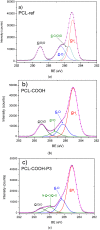Immobilization of Platelet-Rich Plasma onto COOH Plasma-Coated PCL Nanofibers Boost Viability and Proliferation of Human Mesenchymal Stem Cells
- PMID: 30966035
- PMCID: PMC6418517
- DOI: 10.3390/polym9120736
Immobilization of Platelet-Rich Plasma onto COOH Plasma-Coated PCL Nanofibers Boost Viability and Proliferation of Human Mesenchymal Stem Cells
Abstract
The scaffolds made of polycaprolactone (PCL) are actively employed in different areas of biology and medicine, especially in tissue engineering. However, the usage of unmodified PCL is significantly restricted by the hydrophobicity of its surface, due to the fact that its inert surface hinders the adhesion of cells and the cell interactions on PCL surface. In this work, the surface of PCL nanofibers is modified by Ar/CO₂/C₂H₄ plasma depositing active COOH groups in the amount of 0.57 at % that were later used for the immobilization of platelet-rich plasma (PRP). The modification of PCL nanofibers significantly enhances the viability and proliferation (by hundred times) of human mesenchymal stem cells, and decreases apoptotic cell death to a normal level. According to X-ray photoelectron spectroscopy (XPS), after immobilization of PRP, up to 10.7 at % of nitrogen was incorporated into the nanofibers surface confirming the grafting of proteins. Active proliferation and sustaining the cell viability on nanofibers with immobilized PRP led to an average number of cells of 258 ± 12.9 and 364 ± 34.5 for nanofibers with ionic and covalent bonding of PRP, respectively. Hence, our new method for the modification of PCL nanofibers with PRP opens new possibilities for its application in tissue engineering.
Keywords: COOH plasma; PRP immobilization; cell viability; nanofibers; platelet-rich plasma; polycaprolactone.
Conflict of interest statement
The authors declare no conflict of interest.
Figures







Similar articles
-
PRP of T2DM Patient Immobilized on PCL Nanofibers Stimulate Endothelial Cells Proliferation.Int J Mol Sci. 2023 May 5;24(9):8262. doi: 10.3390/ijms24098262. Int J Mol Sci. 2023. PMID: 37175994 Free PMC article.
-
Plasma-Coated Polycaprolactone Nanofibers with Covalently Bonded Platelet-Rich Plasma Enhance Adhesion and Growth of Human Fibroblasts.Nanomaterials (Basel). 2019 Apr 19;9(4):637. doi: 10.3390/nano9040637. Nanomaterials (Basel). 2019. PMID: 31010178 Free PMC article.
-
Immobilization and Release of Platelet-Rich Plasma from Modified Nanofibers Studied by Advanced X-ray Photoelectron Spectroscopy Analyses.Polymers (Basel). 2023 Mar 14;15(6):1440. doi: 10.3390/polym15061440. Polymers (Basel). 2023. PMID: 36987220 Free PMC article.
-
Biodegradable electrospun nanofibers coated with platelet-rich plasma for cell adhesion and proliferation.Mater Sci Eng C Mater Biol Appl. 2014 Jul 1;40:180-8. doi: 10.1016/j.msec.2014.03.065. Epub 2014 Mar 31. Mater Sci Eng C Mater Biol Appl. 2014. PMID: 24857481 Free PMC article.
-
Grafting of gelatin on electrospun poly(caprolactone) nanofibers to improve endothelial cell spreading and proliferation and to control cell Orientation.Tissue Eng. 2005 Jul-Aug;11(7-8):1149-58. doi: 10.1089/ten.2005.11.1149. Tissue Eng. 2005. PMID: 16144451
Cited by
-
Electrospun Biodegradable Nanofibers Coated Homogenously by Cu Magnetron Sputtering Exhibit Fast Ion Release. Computational and Experimental Study.Membranes (Basel). 2021 Dec 8;11(12):965. doi: 10.3390/membranes11120965. Membranes (Basel). 2021. PMID: 34940466 Free PMC article.
-
Synthesis, Self-Assembly, and Drug-Release Properties of New Amphipathic Liquid Crystal Polycarbonates.Nanomaterials (Basel). 2018 Mar 27;8(4):195. doi: 10.3390/nano8040195. Nanomaterials (Basel). 2018. PMID: 29584691 Free PMC article.
-
Ag-Contained Superabsorbent Curdlan-Chitosan Foams for Healing Wounds in a Type-2 Diabetic Mice Model.Pharmaceutics. 2022 Mar 28;14(4):724. doi: 10.3390/pharmaceutics14040724. Pharmaceutics. 2022. PMID: 35456559 Free PMC article.
-
PRP of T2DM Patient Immobilized on PCL Nanofibers Stimulate Endothelial Cells Proliferation.Int J Mol Sci. 2023 May 5;24(9):8262. doi: 10.3390/ijms24098262. Int J Mol Sci. 2023. PMID: 37175994 Free PMC article.
-
Biodegradable Nanohybrid Materials as Candidates for Self-Sanitizing Filters Aimed at Protection from SARS-CoV-2 in Public Areas.Molecules. 2022 Feb 16;27(4):1333. doi: 10.3390/molecules27041333. Molecules. 2022. PMID: 35209122 Free PMC article.
References
-
- Yao Q., Cosme J.G.L., Xu T., Miszuk J.M., Picciani P.H.S., Fong H., Sun H. Three dimensional electrospun PCL/PLA blend nanofibrous scaffolds with significantly improved stem cells osteogenic differentiation and cranial bone formation. Biomaterials. 2017;115:115–127. doi: 10.1016/j.biomaterials.2016.11.018. - DOI - PMC - PubMed
-
- Woodruff M.A., Hutmacher D.W. The return of a forgotten polymer—Polycaprolactone in the 21st century. Prog. Polym. Sci. 2010;35:1217–1256. doi: 10.1016/j.progpolymsci.2010.04.002. - DOI
LinkOut - more resources
Full Text Sources
Research Materials

